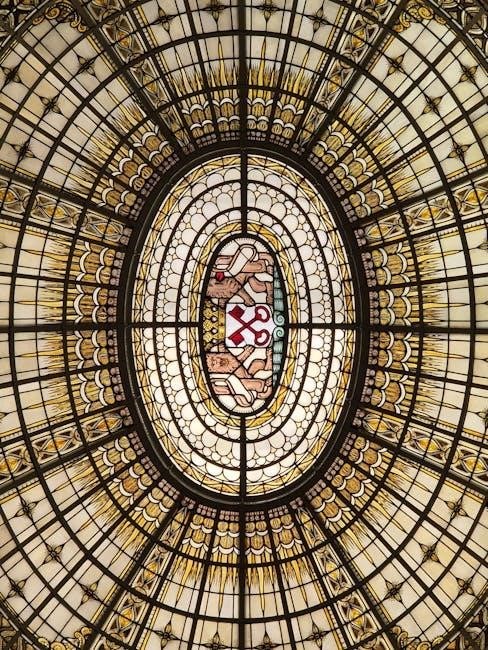Tennessee Williams’ The Glass Menagerie is a timeless masterpiece, now widely available in PDF format, enhancing accessibility for modern readers and scholars. Its enduring themes of family dynamics, illusion, and fragility resonate universally, making it a cornerstone of American theatre. The PDF version has become a popular resource for educational purposes, offering a convenient way to study the play’s intricate characters and symbolic depth. This format ensures Williams’ poignant exploration of human emotions remains relevant and accessible to new generations.
1.1 Overview of the Play
The Glass Menagerie, Tennessee Williams’ iconic play, revolves around the Wingfield family’s struggles in St. Louis during the Great Depression. The narrative, semi-autobiographical, explores themes of illusion, fragility, and escape through the perspectives of Tom, Amanda, and Laura. The PDF version captures the play’s poignant dialogue and symbolic depth, offering readers a vivid portrayal of a dysfunctional family navigating reality and fantasy. Its accessibility has made it a staple in educational resources and literary studies.
1.2 Historical Context and Significance
The Glass Menagerie, set during the Great Depression, reflects the economic and social struggles of the era. Tennessee Williams’ semi-autobiographical work captures the fragility of the American Dream and the suffocating realities of poverty. The play’s historical significance lies in its raw portrayal of family dynamics under societal pressure. The PDF version highlights these themes, making it a vital resource for understanding the play’s cultural and historical relevance in modern studies.
Plot Summary
The play revolves around the Wingfield family’s struggles, Amanda’s relentless pursuit of a suitor for Laura, and Tom’s longing for escape, culminating in Jim O’Connor’s disappointing visit.
2.1 The Wingfield Family Dynamics
The Wingfield family, central to The Glass Menagerie, is portrayed as dysfunctional and emotionally strained. Amanda, the overbearing mother, clings to her past glory, dominating her children, Tom and Laura. Tom, the conflicted brother, yearns for freedom from his stifling home life, while Laura, shy and fragile, struggles with her physical disability and social isolation. Their dynamics are marked by tension, unspoken resentments, and a desperate longing for escape, as revealed in the PDF version of the play.
2.2 The Role of Tom, Amanda, and Laura
Tom, Amanda, and Laura Wingfield are central figures in The Glass Menagerie, each embodying distinct struggles. Amanda, a faded Southern belle, obsessively clings to her past, dominating her children. Tom, the narrator, is torn between his loyalty to his family and his desire for freedom. Laura, fragile and shy, retreats into her glass menagerie, symbolizing her delicate emotional state. Their complex relationships form the emotional core of the play, as detailed in the PDF version.
2.3 The Arrival of Jim O’Connor
Jim O’Connor’s arrival sparks hope and tension in the Wingfield household. As a potential suitor for Laura, he represents a chance for her to escape her sheltered life. His charm and kindness momentarily lift the family’s spirits, but his engagement to another woman shatters Laura’s fragile dreams. The PDF version highlights how Jim’s visit symbolizes the clash between illusion and reality, leaving lasting emotional scars on the Wingfield family.

Major Themes
The play explores illusion vs. reality, escape, and emotional fragility, themes amplified by the PDF version’s accessibility, making it a vital educational resource.
3.1 The Illusion of Reality vs; Fantasy
In The Glass Menagerie, the PDF version highlights Amanda’s romanticized past and Laura’s escape into her glass collection, blurring reality and fantasy. This theme is central to the play’s emotional depth, as characters cling to illusions to cope with their disillusioning lives. The PDF format enhances accessibility, allowing readers to delve into Williams’ exploration of how fantasy serves as both a refuge and a barrier to truth and connection.
3.2 The Struggle for Escape and Freedom
In The Glass Menagerie, the PDF version underscores the characters’ longing for liberation. Tom, trapped by familial obligations, yearns to escape his stifling reality, while Laura seeks refuge in her fragile glass world. Amanda, clinging to her past, struggles to accept her present. The play’s exploration of freedom, highlighted in the PDF, reveals the tension between illusion and reality, as each character navigates their own form of captivity and the elusive hope of escape.
3.3 The Fragility of Human Emotions
The PDF version of The Glass Menagerie vividly portrays the delicate nature of human emotions through its characters. Amanda’s anxiety over her family’s future, Laura’s shy demeanor, and Tom’s internal conflict highlight the fragility of emotional states. The play’s emotional depth, amplified in the PDF format, allows readers to deeply connect with the characters’ struggles, emphasizing the universal vulnerability of human feelings and the impact of societal pressures.
Character Analysis
The PDF version of The Glass Menagerie delves into the complexities of its characters, such as Amanda’s overbearing nature, Laura’s fragility, and Tom’s inner turmoil, providing deep insight into their roles and motivations.
4.1 Amanda Wingfield: The Overbearing Mother
Amanda Wingfield, the matriarch, is a complex figure dominated by her past glory and obsession with securing her daughter Laura’s future. Her controlling nature and delusions of grandeur often lead to emotional turmoil within the family. The PDF version highlights her manipulative behavior, particularly in her treatment of Tom, as she clings to the hope of restoring the family’s lost status. Her actions, though well-intentioned, exacerbate the family’s dysfunction and isolation.
4.2 Laura Wingfield: The Shy and Fragile Sister
Laura Wingfield, portrayed as the shy and fragile sister, embodies vulnerability and innocence. Her physical disability and social anxiety isolate her, making her dependent on her family. The glass menagerie symbolizes her delicate nature, reflecting her emotional fragility. In the PDF version, her character is deeply explored, highlighting her struggle to connect with the world outside her sheltered existence. Her isolation and uniqueness evoke both pity and admiration, making her a poignant figure in the play.
4.3 Tom Wingfield: The Torn Brother
Tom Wingfield, the narrator and Amanda’s son, is a complex character torn between loyalty and escape. He feels trapped by his family’s expectations and his job, yearning for adventure. His internal conflict is evident in his dual role as caregiver and aspiring poet. The PDF version highlights his emotional struggle, as he ultimately abandons his family to pursue freedom, leaving behind the fragile world of his mother and sister.
4.4 Jim O’Connor: The Disillusioned Suitor
Jim O’Connor, a charming but unattainable figure, represents a fleeting hope for Laura. His engagement elsewhere and casual demeanor highlight his disconnection from the Wingfields’ fragile world. The PDF version underscores his role as a symbol of lost opportunities, as his brief interaction with Laura ends in heartbreak, leaving her more isolated. Jim’s character embodies the illusion of connection in a world where true understanding seems impossible, adding to the play’s poignant tragedy.
Symbolism in the Play
The glass menagerie symbolizes Laura’s fragility, while the fire escape represents escape attempts. The unicorn embodies Laura’s uniqueness and isolation, highlighting themes of shattered illusions and longing.
5.1 The Glass Menagerie as a Symbol of Fragility
The glass menagerie represents Laura’s delicate nature and the fragility of her world. Each glass animal symbolizes the breakable reality of the Wingfield family’s lives. Laura’s attachment to the menagerie reflects her vulnerability and inability to cope with the harshness of the real world. The glass, like Laura, is easily shattered, emphasizing the precariousness of their existence and the inevitability of loss. This symbolism underscores the play’s themes of fragility and disillusionment.
5.2 The Fire Escape: A Symbol of Escape
The fire escape in The Glass Menagerie serves as a symbolic bridge between the Wingfield family’s suffocating reality and the outside world. It represents Tom’s longing for freedom and escape from his oppressive home life. The fire escape is both a physical and emotional pathway, highlighting the tension between confinement and liberation. Its presence underscores the characters’ struggles to break free from their fragile circumstances and the illusion of a better life beyond their shattered realities.
5.3 The Unicorn: A Symbol of Uniqueness and Isolation
The unicorn in Laura’s glass menagerie symbolizes her uniqueness and isolation. Its rarity and delicate beauty mirror her own fragile identity. The unicorn’s broken horn after Jim’s handling signifies the loss of innocence and the shattering of illusions. This symbol highlights Laura’s struggle to connect with the world, emphasizing her emotional fragility and the impossibility of escaping her isolated reality. The unicorn remains a poignant metaphor for her singular, unattainable existence.

Historical and Cultural Context
The Glass Menagerie reflects the post-Depression era’s societal struggles and Tennessee Williams’ personal experiences, offering a poignant glimpse into the fragility of the American Dream and familial dynamics.
6.1 The Great Depression and Its Impact
The Great Depression deeply influenced The Glass Menagerie, reflecting economic struggles and societal despair. The Wingfield family’s financial hardships mirror the era’s widespread poverty, while their emotional fragility underscores the psychological toll of the Depression. The play’s themes of lost security and fading illusions resonate with the experiences of many during this period. The PDF version highlights these historical nuances, making the play’s relevance accessible for modern readers studying its cultural significance.
6.2 Tennessee Williams’ Personal Influences
Tennessee Williams drew heavily from his personal life when crafting The Glass Menagerie. His complex relationship with his mother and sister, Rose, who struggled with mental health, deeply influenced the characters of Amanda and Laura. The play’s themes of fragility and illusion reflect Williams’ own experiences with family dynamics and societal pressures. The PDF version of the play highlights these autobiographical elements, offering readers a deeper understanding of Williams’ emotional and psychological inspirations.
Adaptations and Performances
The Glass Menagerie has been adapted into numerous stage productions, including a 70-minute version directed by Mohammad Berahmani and Saeed Zarei, performed daily at Entezami Hall. The PDF version highlights its enduring popularity, with revivals planned at Dundee Rep in 2025, showcasing its timeless appeal and theatrical significance.

7.1 Notable Stage Productions
The Glass Menagerie has seen numerous notable stage productions, including a 70-minute adaptation directed by Mohammad Berahmani and Saeed Zarei, performed daily at Entezami Hall. The play’s revival at Dundee Rep in 2025 highlights its enduring theatrical appeal. Masterworks Theater’s production, featuring Doug Harris as Jim O’Connor, further showcases its timeless relevance. These adaptations demonstrate the play’s ability to captivate audiences across different interpretations and staging styles, solidifying its place in theatre history.
7.2 Film and Television Adaptations
The Glass Menagerie has been adapted into several film and television productions, each capturing the play’s emotional depth. Notable adaptations include a 70-minute version featuring Doug Harris as Jim O’Connor and Olivia Washington as Laura Wingfield. These adaptations maintain the original’s poignant themes, offering a visual interpretation of Williams’ timeless story. The PDF format of the play complements these adaptations, providing a resource for comparing textual and visual representations of the narrative.

7.3 Modern Interpretations and Reimaginations
The Glass Menagerie continues to inspire modern adaptations, blending traditional themes with contemporary perspectives. A 70-minute production at Entezami Hall, directed by Mohammad Berahmani and Saeed Zarei, offers a fresh take on Williams’ classic. Additionally, The Yard Theatre’s reimagined version highlights the play’s timeless appeal. These interpretations, alongside the PDF version’s accessibility, ensure the story remains relevant, allowing new audiences to connect with its universal themes of family, illusion, and fragility.
Critical Reception and Reviews
The Glass Menagerie received widespread acclaim for its poignant portrayal of family dynamics and emotional depth. The PDF version has further enhanced its accessibility, allowing modern critics and scholars to delve into Williams’ masterpiece with ease, ensuring its enduring relevance in literary and theatrical discourse.
8.1 Initial Reception in 1944
Tennessee Williams’ The Glass Menagerie premiered in 1944 to critical acclaim, marking a milestone in American theatre. The play’s emotional depth and nuanced characters resonated deeply with audiences. Critics praised its exploration of illusion versus reality, with Amanda and Laura’s struggles captivating viewers. The PDF version has preserved this initial acclaim, offering modern readers a glimpse into the play’s groundbreaking debut and its enduring impact on literary and theatrical history.
8.2 Modern Critiques and Praises
Modern critiques of The Glass Menagerie highlight its enduring relevance, with scholars praising its emotional depth and universal themes. The play’s exploration of illusion and reality continues to captivate audiences, while its character dynamics remain a focal point of analysis. Some critics note its pacing challenges, yet the PDF version has made it easier for contemporary readers to engage with Williams’ masterpiece, ensuring its legacy endures in both academic and theatrical circles.

Awards and Recognition
The Glass Menagerie has garnered numerous accolades, including BroadwayWorld Awards for Best Direction and acting categories. Its timeless appeal is further highlighted by its popularity in PDF format, widely used in educational resources and study guides, cementing its legacy as a literary and theatrical masterpiece.
9.1 BroadwayWorld Awards
The Glass Menagerie has earned prestigious BroadwayWorld Awards, including Best Direction of a Play for John Tiffany and Best Featured Actor and Actress for Brian J. Smith and Celia Keenan-Bolger. These accolades highlight the play’s theatrical excellence and enduring appeal. The PDF version of the play has further enhanced its accessibility, making it a valuable resource for study and appreciation of Williams’ masterpiece, ensuring its legacy endures in both digital and stage formats.
9.2 Other Notable Accolades
The Glass Menagerie has received widespread acclaim beyond BroadwayWorld Awards, solidifying its status as a theatrical masterpiece. Its revivals, such as those at Dundee Rep, showcase its enduring appeal. The play’s influence on American theatre is profound, with its themes and characters remaining relevant. The PDF version has further amplified its reach, making it a staple in educational resources and study guides, ensuring its legacy continues to inspire new audiences and scholars alike.

The Significance of the PDF Version
The PDF version of The Glass Menagerie enhances accessibility, allowing readers to engage with Tennessee Williams’ masterpiece anytime, anywhere. Its popularity stems from its convenience and clarity, making it a valuable resource for both casual readers and academic study. The format ensures the play’s themes and symbolism are preserved, maintaining its artistic integrity while reaching a broader audience.
10.1 Accessibility and Popularity of the PDF Format
The PDF version of The Glass Menagerie has gained immense popularity due to its accessibility and convenience. Readers can easily download and access the play on various devices, making it ideal for study and reference. The format ensures that the text remains clear and well-formatted, preserving the original intent of Tennessee Williams’ work. Its widespread availability has made it a preferred choice for students, researchers, and theatre enthusiasts worldwide, enhancing its educational and cultural impact.
10.2 Study Guides and Educational Resources
The PDF version of The Glass Menagerie is often accompanied by comprehensive study guides, enhancing its educational value. These resources include detailed character analyses, thematic explorations, and historical context, making it easier for students to grasp the play’s complexity. Discussion questions, essays, and critical insights are also provided, aiding in deeper understanding. Such materials are invaluable for both students and educators, fostering a richer engagement with Williams’ seminal work.

Cultural Impact
The PDF version of The Glass Menagerie has broadened its reach, influencing modern theatre and literature. Its themes resonate globally, shaping emotional and social narratives across cultures and generations.

11.1 Influence on American Theatre
The Glass Menagerie revolutionized American theatre by redefining dramatic storytelling. Its emotional depth and symbolic richness inspired playwrights, shaping modern theatre’s focus on psychological complexity. The play’s exploration of family dynamics and illusion vs. reality remains a benchmark. The PDF version has further amplified its influence, making it accessible for study and performance, ensuring its continued relevance in contemporary American theatre and beyond.
11.2 Impact on Literature and Society
Tennessee Williams’ The Glass Menagerie has profoundly influenced American literature and society. Its exploration of mental health, societal pressures, and family dynamics resonated deeply, sparking conversations about vulnerability and isolation. The play’s themes of illusion vs. reality continue to inspire writers and artists. The PDF version has further cemented its place in educational curricula, ensuring its relevance in modern discussions about identity and human emotion, making it a timeless societal touchstone.
Tennessee Williams’ The Glass Menagerie remains a profound exploration of human fragility and illusion. Its PDF version ensures timeless accessibility, preserving its emotional depth for future generations.
12.1 Final Thoughts on the Play’s Relevance

Tennessee Williams’ The Glass Menagerie continues to captivate audiences with its universal themes of family, illusion, and fragility. The PDF version enhances accessibility, making it a vital resource for modern readers and scholars. Its exploration of human emotions and societal pressures remains deeply relevant, ensuring the play’s enduring legacy in both educational and cultural contexts. The PDF format bridges generations, preserving Williams’ poignant storytelling for future exploration and appreciation.
12.2 The Enduring Legacy of “The Glass Menagerie”
Tennessee Williams’ The Glass Menagerie remains a cornerstone of American theatre, its legacy amplified by the convenience of the PDF format. This accessibility has ensured its continued relevance in educational and cultural contexts, inspiring countless adaptations and interpretations. The play’s exploration of human fragility and societal pressures continues to resonate, solidifying its place as a timeless classic in both literary and theatrical realms, enduring for generations to come.
